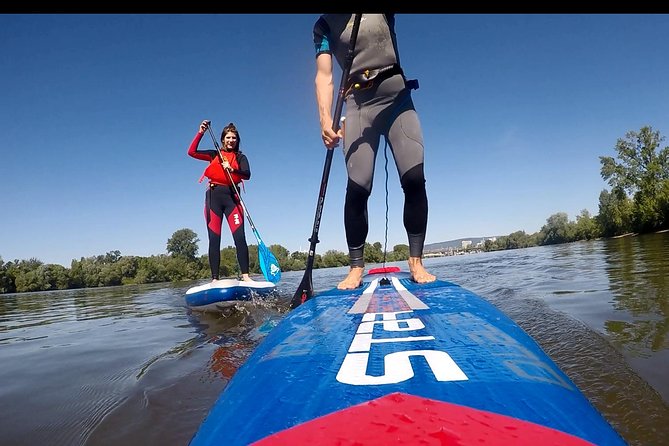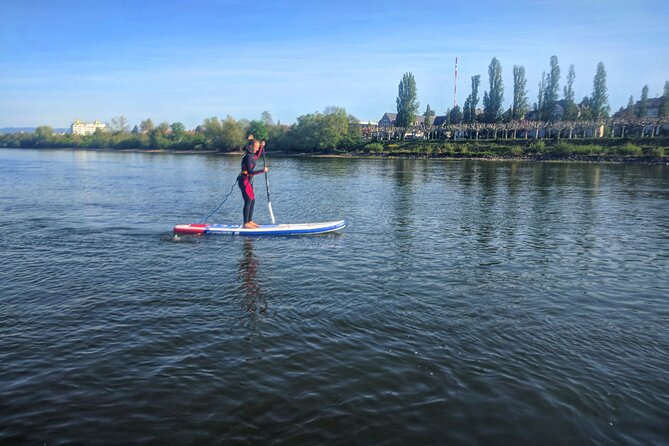Have you ever wondered what it feels like to walk on water? Stand-up paddleboarding (SUP) offers an exhilarating experience that allows you to do just that.
Imagine gliding across the water’s surface, feeling the gentle spray on your face, and soaking in the breathtaking views around you.
But SUP is not just about the thrill; it’s also a fantastic way to stay active, improve your balance, and connect with nature.
So, if you’re ready to embark on a water adventure like no other, join us as we dive into the world of stand-up paddleboarding, where excitement and tranquility collide.
Good To Know

- Stand-up paddleboarding is a full-body workout that engages the core, arms, and legs.
- It improves strength, balance, and cardiovascular fitness.
- Stand-up paddleboarding is a low-impact activity suitable for all ages and fitness levels.
- It allows individuals to explore scenic locations and enjoy the thrill of gliding across the water.
Benefits of Stand-up Paddleboarding (SUP)

Stand-up paddleboarding (SUP) offers a thrilling and invigorating way to explore the waterways, providing a multitude of benefits for adventure enthusiasts and fitness enthusiasts alike. This exciting water sport not only allows individuals to explore scenic locations and enjoy the thrill of gliding across the water, but it also offers numerous health benefits.
SUP is a fantastic full-body workout that engages the core, arms, and legs, helping to improve strength, balance, and cardiovascular fitness. Plus, paddleboarding is a low-impact activity that’s gentle on the joints, making it suitable for people of all ages and fitness levels.
On top of that, stand-up paddleboarding has a minimal environmental impact compared to other water sports, as it doesn’t require any motorized equipment and doesn’t disturb marine life or ecosystems.
Find more activities and experiences we've covered in Mainz.
Essential Equipment for Stand-up Paddleboarding
To fully enjoy the thrilling and invigorating experience of stand-up paddleboarding (SUP), it’s essential to have the right equipment.
Stand-up paddleboarding techniques require a few key accessories to enhance your performance and keep you safe on the water.
One of the most important pieces of equipment is the paddleboard itself. It should be sturdy, stable, and suitable for your skill level.
Plus, a high-quality paddle is crucial for efficient paddling and maneuverability.
To ensure your safety, a leash is essential to keep you connected to your board in case of unexpected falls.
Other important accessories include a personal flotation device (PFD), which is recommended for all paddlers, especially beginners, and proper attire such as a wetsuit or rash guard to protect you from the elements.
With the right equipment, you’ll be ready to embark on exciting SUP adventures.
Safety Guidelines for Stand-up Paddleboarding
For a safe and thrilling stand-up paddleboarding experience, it’s essential to follow these safety guidelines:
- Always wear a properly fitting personal flotation device (PFD) or life jacket.
- Be aware of your surroundings and avoid crowded areas to prevent collisions.
- Use a leash to keep your paddleboard attached to you in case you fall off.
- Check the weather conditions before heading out and avoid paddleboarding in strong winds or storms.
- Learn the proper technique for paddling and turning to maximize your efficiency and control.
Choosing the Right Location for Stand-up Paddleboarding
After familiarizing yourself with the safety guidelines for stand-up paddleboarding, the next step is to choose the perfect location to embark on your paddleboarding adventure. The best time for stand-up paddleboarding is typically during the warmer months when the weather is pleasant and the water is calm. Some popular destinations for paddleboarding include:
| Destination | Best Time to Visit |
|---|---|
| Hawaii | Summer |
| California | Spring and Fall |
| Florida Keys | Winter |
Hawaii is a paradise for paddleboarding enthusiasts, offering crystal clear waters and stunning scenery. California is known for its beautiful coastline and diverse paddleboarding spots. The Florida Keys provide calm and shallow waters, perfect for beginners.
No matter which destination you choose, make sure to check local regulations and weather conditions before heading out. Safety should always be a top priority when paddleboarding.
Tips for Improving Your Stand-up Paddleboarding Skills
Enjoy the thrilling world of stand-up paddleboarding as you discover tips and techniques to enhance your skills on the water. Here are some valuable insights to help you improve your stand-up paddleboarding abilities:
Find your balance: One of the most common mistakes beginners make isn’t finding their balance on the board. Stand with your feet shoulder-width apart and keep your gaze focused on the horizon to maintain stability.
Paddle with purpose: Use your paddle efficiently by engaging your core and using your whole body to propel yourself forward. Avoid using just your arms, as this can lead to fatigue.
Master the turns: To execute smooth turns, use sweeping strokes and lean into the turn. Remember to distribute your weight evenly on the board to maintain stability.
Practice advanced techniques: Once you have mastered the basics, challenge yourself with advanced techniques such as pivot turns, cross-stepping, and riding waves.
Stay safe: Always wear a leash to keep yourself connected to the board. Be aware of your surroundings and avoid crowded areas to prevent collisions.
Common Questions
What Is the Minimum Age Requirement for Stand-Up Paddleboarding (Sup)?
The minimum age requirement for stand-up paddleboarding (SUP) is 12 years old. Safety regulations ensure that participants can swim freely for 15 minutes and have no fear of water.
Is Previous Experience Required for Stand-Up Paddleboarding (Sup)?
Previous experience is not required for stand-up paddleboarding (SUP). It is beginner-friendly, making it accessible to those new to the sport. So, anyone can try it out and enjoy the adventure on the water.
Are There Any Weight Restrictions for Stand-Up Paddleboarding (Sup)?
There are weight limits and safety regulations to consider when participating in stand-up paddleboarding (SUP). These restrictions ensure the safety of participants and maintain the integrity of the activity.
Can I Bring My Own Wetsuit or Life Jacket for the Activity?
Yes, guests are allowed to bring their own wetsuit or life jacket for the activity. However, it is important to note that there are safety regulations in place to ensure the equipment meets the necessary standards.
Is It Possible to Bring a Non-Participating Companion on the Stand-Up Paddleboarding (Sup) Tour?
Yes, it is possible to bring a non-participating companion on the stand-up paddleboarding (SUP) tour. However, it is important to adhere to safety guidelines for stand-up paddleboarding to ensure the well-being of everyone involved.
The Sum Up
To sum it up, stand-up paddleboarding (SUP) offers a thrilling and unique way to explore the water. Whether you’re a beginner or an experienced paddler, SUP provides a combination of adventure and tranquility as you glide through calm lakes or ride ocean waves.
With the right equipment, safety guidelines, and practice, you can improve your skills and fully enjoy the benefits of this exhilarating water sport.
So grab your paddleboard and embark on an unforgettable adventure on the water with stand-up paddleboarding.
More Tour Reviews in Mainz
- Guided tour in Mainz on the Rhine in german and english
- Mainz: Old Town & St. Stephen’s with Chagall windows
- Mainz: All-Inclusive Advent Evening Cruise
- Mainz: The Gutenberg Museum – World Museum of the Art of Printing
- Mainz: Light & History in the Old Cathedral of St. John (Mainz Lights Up)
- Mainz: Golden Mainz and its sights
Looking for something different? Other Mainz activities we've written about
- Guided tour in Mainz on the Rhine in german and english
- Mainz: Old Town & St. Stephen’s with Chagall windows
- Mainz: All-Inclusive Advent Evening Cruise
- Mainz: The Gutenberg Museum – World Museum of the Art of Printing
- Mainz: Light & History in the Old Cathedral of St. John (Mainz Lights Up)
- Mainz: Golden Mainz and its sights
- Private Xmas Market Hopping with gondola ride & wine tasting
- Mainz Private Guided Walking Tour with Local Guide
- Mainz Interactive City Tour
- Evening walking tour of Mainz Rhine bank and Old Town
- Mainz: guided evening tour of the Rhine riverbank/old town in German and English
- Mainz: Evening Wine Tasting in a spectacular Historic Cellar
